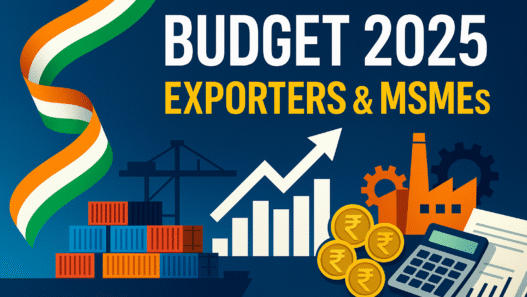The Finance Minister grouped exports and MSMEs among the four growth engines meant to power the economy toward its Viksit Bharat target. Together these engines decide how cheaply you can borrow, how fast you can clear customs and how wide your markets reach. The following briefing removes jargon and maps every new announcement to a practical lever you can pull inside the factory, the finance office or the export documentation desk.
Table of Contents
1 One‑minute scoreboard
| Key metric | Pre‑budget | Budget 2025 figure | Why it matters |
|---|---|---|---|
| MSME investment limit | Existing threshold | 2.5 times higher | Firms can scale without losing priority benefits. |
| MSME turnover limit | Existing threshold | 2 times higher | More headroom before compliance burden shifts. |
| Credit guarantee cover (MSE) | ₹5 crore | ₹10 crore | Higher unsecured limits for plant modernisation. |
| Credit guarantee cover (exporter MSMEs & start‑ups) | ₹10 crore | ₹20 crore | Longer tenor term loans shield cash cycles. |
| Personal income tax – zero tax threshold | ₹7 lakh | ₹12 lakh | More take‑home for founder‑salaries and employees alike. |
2 A broader launchpad for MSMEs
2.1 Enlarged definition brings safety net when you grow
The investment and turnover ceilings that decide whether you stay micro, small or medium rise 2.5 times and 2 times. A unit once nervous about breaching the cap can now add a second CNC line or a new packaging wing without forfeiting access to priority‑sector lending or public procurement quotas.
2.2 Credit flows get deeper and cheaper
- Credit Guarantee Fund Trust for Micro and Small Enterprises (CGTMSE) now backs working‑capital and term loans up to ₹10 crore for MSEs. The reduced guarantee fee cuts the effective rate by roughly 50 basis points.
- Exporter‑MSMEs obtain a bespoke window that guarantees term loans up to ₹20 crore. Use this to lock in capex for food‑processing plants, tannery upgrades or cold‑chain assets before demand spikes.
- Udyam Credit Card debuts with a ₹5 lakh revolver limit. Ten lakh cards are slated for year one, aimed at tiny suppliers who need to bridge invoice gaps without pledging collateral.
2.3 Equity taps widen
Fund of Funds 2.0 adds another ₹10,000 crore to anchor venture and growth equity vehicles, while a fresh term‑loan scheme offers up to ₹2 crore to first‑time women, SC and ST entrepreneurs. Angel investors and NBFCs can co‑invest alongside the state at moderated risk.
3 An export express lane
3.1 Export Promotion Mission – single‑window muscle
A new inter‑ministerial mission will set sectoral targets and whip up joint task forces spanning Commerce, MSME and Finance. Expect quicker resolution of duty drawback glitches, faster disbursal under the Remission of Duties and Taxes on Exported Products (RoDTEP) scheme and drafting help to navigate non‑tariff barriers in key markets.
3.2 BharatTradeNet – digital rails for paperwork and credit
Think of BTN as the GSTN of international trade. When it goes live it will knit together customs, DGFT, ports, banks and insurers on one interface. Exporters will file a single electronic bill that spawns shipping bills, e‑waybills, insurance covers and export credit requests, eliminating duplicate data entry and shaving days off the cash‑conversion cycle.
3.3 Customs duty reshuffles that fatten margins
- Handicrafts – time limit to ship finished goods made from duty‑free inputs extends from six months to one year, with an optional three‑month grace. Nine more raw‑material lines enter the duty‑free list.
- Leather – import BCD on wet‑blue leather is scrapped, encouraging domestic value addition. Export duty on crust leather falls from 20 percent to nil, granting small tanners an immediate price edge overseas.
- Marine products – BCD on frozen fish paste drops from 30 percent to 5 percent, and fish hydrolysate from 15 percent to 5 percent, lifting competitiveness for seafood exporters.
- Technical textiles and shuttle‑less looms – two additional loom categories now import duty‑free, lowering equipment costs for agro‑textile and geo‑textile manufacturers.
3.4 Trade facilitation – less red tape, clearer timelines
- Provisional customs assessments must now close within two years, extendable by one. Reduced uncertainty helps planning for high‑value capital‑goods imports.
- Importers or exporters may voluntarily declare overlooked details after clearance, pay the duty plus interest and walk away free of penalties. The carrot encourages clean compliance rather than litigation.
- The end‑use period for inputs procured under concessional‑duty rules stretches from six months to one year, and the return filing frequency shifts from monthly to quarterly.
3.5 Rationalised tariff grid
Seven tariff rates disappear, leaving a simpler eight‑rate structure. The government pledges that no product will carry more than one cess, and Social Welfare Surcharge is lifted on 82 tariff lines that already bear a cess, trimming landed costs in niche categories.
4 Tax tweaks that boost cash flow
- Personal income tax – no tax payable up to ₹12 lakh (₹12.75 lakh for salaried individuals once the standard deduction is counted). Slabs climb gently in 5 lakh rupee steps until the 30 percent band triggers above ₹24 lakh.
- TDS and TCS relief – the rent‑related TDS threshold rises to ₹6 lakh per year, and outward remittances under the Liberalised Remittance Scheme for education escape TCS within ₹10 lakh, freeing working capital for owners funding family expenses abroad.
5 Infrastructure and logistics unlocks
- Maritime Development Fund – ₹25,000 crore is earmarked for modern berths, coastal shipping and shipbuilding incentives. Expect faster container cycling and lower coastal feeder charges.
- Asset Monetisation Plan 2.0 – targeting ₹10 lakh crore, the plan will pump proceeds into highways, dedicated freight corridors and inland waterways, trimming factory‑to‑port transit times.
- Air‑cargo warehousing – the budget sets aside funds to upgrade temperature‑controlled storage at key airports, vital for exporters of perishables and high‑value pharma consignments.
- PM Gati Shakti data access – private players gain read‑only access to multimodal infrastructure maps, helping logistics teams optimise route planning.
6 Ready‑to‑apply checklist
- Update your Udyam registration to reflect the new investment and turnover ceilings so that bank algorithms flag you as MSME‑eligible.
- Negotiate larger limits – approach banks for incremental working‑capital or term‑loan lines under the expanded credit guarantee. Emphasise the reduced guarantee fees during pricing talks.
- Audit documentation workflows – move toward full‑stack digital invoices and shipping bills to be BTN‑ready the day it launches.
- Re‑cost your export quotes – factor in immediate duty savings on leather, seafood, handicrafts and technical‑textile inputs, and pass a portion of the margin to buyers for a price advantage.
- Train your compliance team on voluntary post‑clearance disclosure provisions to avert penalties.
- Realign salary structures – shift more of owner‑draws into salary up to ₹12 lakh to exploit the zero‑tax slab, and calibrate ESOP exercises for the new bands.
- Map upcoming infra projects – bookmark tenders and PPP announcements in roads, rail and ports that cut lead times to your primary gateway.
7. Outlook
Budget 2025 bends the policy curve toward scale, speed and simplicity. Duty cuts lift sector‑specific margins, new credit lines shrink capital hurdles and a digital trade backbone promises to erase paperwork drag. Manufacturers that recalibrate plant capacity, financing and export‑market outreach within the next two quarters will be best placed to ride the demand upswing the mission intends to unlock.










